Civil-Rights-美国民权运动背景知识
美国民权运动

美国民权运动1960年代,美国经历了一场重大的社会运动——民权运动。
这场运动旨在争取黑人平等的权利和消除种族隔离。
它的兴起和发展是由于个别黑人领袖和广大民众的共同努力,以及他们对美国宪法所明确规定的平等原则的坚持。
1. 背景1.1 种族隔离的存在在二十世纪早期,美国南部的许多州实行了严格的种族隔离政策。
黑人与白人被完全分离,被剥夺了平等的机会和权利。
巴士、学校、餐馆等公共场所都设立了种族隔离的制度,这导致了黑人社区的贫困和不公平待遇。
1.2 马丁·路德·金恩和非暴力抗议马丁·路德·金恩是美国民权运动的代表人物之一。
他是一位非暴力抗议的倡导者,他通过演讲和抗议行动,呼吁平等和公正。
他的著名演讲《我有一个梦想》成为运动的标志,鼓舞了广大黑人民众的斗志。
2. 运动发展2.1 坐式抗议运动的一个重要策略是坐式抗议。
通过在白人专区的巴士上坐下来拒绝让座,黑人民众向整个国家展示了他们的不满和对平等权利的追求。
著名的蒙哥马利公交车抗议事件是这一策略的一个重要里程碑。
2.2 学校集会和游行学生和年轻人在民权运动中起到了重要的作用。
他们组织了学校集会和游行,表达他们对种族歧视的不满和对平等教育权利的渴望。
他们用自己的力量推动了整个运动的发展。
3. 成果和影响3.1 《民权法案》的通过基于民权运动的斗争和压力,美国国会通过了《民权法案》。
该法案废除了各种形式的种族隔离制度,并保障了黑人的投票权和平等受教育权。
这标志着民权运动取得了重要的胜利。
3.2 社会变革和意识觉醒民权运动对美国社会产生了深远的影响。
它改变了种族关系的格局,促进了不同种族之间的相互理解和团结。
它唤醒了公众对种族不平等的意识,推动了其他社会运动的兴起,如女权运动和LGBTQ+权益运动。
4. 结论美国民权运动为黑人争取平等权利和消除种族隔离做出了巨大贡献。
它的兴起改变了美国社会的面貌,既是一场历史性的斗争,也是一次深刻的意识觉醒。
介绍一个典型案例,运用辩证唯物主义和历史唯物主义

介绍一个典型案例,运用辩证唯物主义和历史唯物主义理论,去分析其历史背景,让读者能够深入了解这个案例这里我们介绍的案例为美国黑人民权运动。
黑人民权运动(African-American Civil Rights Movement)是一场反对美国种族歧视的运动,历时从1954年的“圣路易斯公民权诉Brown案”以来,持续直至1965年的《民权法案》签署实现美国个人民权得到彻底解放之时。
借助辩证唯物主义和历史唯物主义理论,我们可以发掘黑人民权运动的历史背景。
根据辩证唯物主义和历史唯物主义的观点,美国黑人民权运动的发展是由社会发展的连续不断的过程驱动的。
它是一种由社会矛盾引起的普遍性事件,社会矛盾的发展与解决过程决定了它的发展性质、方向和步骤。
具体而言,以美国黑人民权运动为例,历史背景可以从黑人集体获得自由、决定自己命运的早期遗留问题到当前种族主义社会所产生的种族歧视持续存在,可以分析出起源。
具体来说,从历史上看,美国黑人民权运动是一种反对种族歧视的运动,它源自黑人社会,早期源自黑人被奴隶制统治并被剥夺了基本权利的历史,由于种族歧视,立法、教育、经济和社会等存在明显的不平等。
最明显的反映是新南向的实施,使不少黑人被遗弃,他们必须走上应对当局的抗争路线,争取民权。
再深入来看,美国黑人民权运动的发展基础是美国的唯物的思想和思潮,从具体行动、到社会斗争,都是基于宣扬和争取社会公平与正义的理念和行为。
美国黑人民权运动既是受到历史所限所影响,又受到西方文化传播影响,它具有社会运动理论作为特点,即思想是实践的前提,实践是思想的运动,二者相互促进,相互联系的时间性质的绩效能力,以及一定程度上的唯物主义和社会主义理论。
总的来说,以美国黑人民权运动为例,借助辩证唯物主义和历史唯物主义理论,它可以更加深入地解读这场历史运动的历史背景和社会意义,使读者能够深入了解。
美国黑人民权运动

美国黑人民权运动(African-American Civil Rights Movement,又译为“非裔美国人民权运动”),美国民权运动的一部分,于1950年代兴起,直至1970年代,乃是经由非暴力的抗议行动,争取非裔美国人民权的群众斗争。
20世纪50年代中期至60年代中期美国黑人反对种族歧视和种族压迫,争取政治经济和社会平等权利,1954年美国联邦最高法院判定教育委员会种族隔离的学校违法,1955年阿拉巴马州蒙哥马利市,黑人公民以全面罢乘来反对公车上的黑白隔离措施,1963年华盛顿的林肯纪念馆广场聚集二十五万名群众反种族隔离,美国民权运动领袖马丁·路德·金博士发表著名的演说《我有一个梦》为民权运动的高峰,其他参与的著名人物还有麦尔坎·X (Malcolm X)等人。
百年前林肯虽解放了黑奴,但黑人平等的公民权在南方却从未获落实,直到金博士领导民权运动才获得成功,1960年代美国民权运动兴起,对其社会及留学生有很大影响,当时对少数民族及妇女的权力均受到重视,开拓了新的视野,金博士也因此获颁1964年诺贝尔和平奖。
战后头10年,美国黑人争取平等自由的运动只限于由美国全国有色人种协进会在法院进行的斗争。
1954 年5月17日,美国最高法院为改变美国在国际上的形象,就布朗控诉托布卡教育委员会一案作出判决:公立学校所实行的种族隔离教育是不平等的,违反《美利坚合众国宪法第14条修正案》。
1955 年12月1日,亚拉巴马州蒙哥马利城黑人罗莎·帕克斯夫人在公共汽车上拒绝让座给白人,被捕入狱。
因为她的被捕还引发了蒙哥马利巴士抵制运动(MontgomeryBus Boycott )。
在黑人牧师马丁·路德·金的领导下,全城5万黑人团结一致,罢乘公共汽车达一年之久,终于迫使汽车公司取消种族隔离制。
1957年,金牧师及其支持者组成南方基督教领袖会议,将运动深入到南部生活的各个领域。
美国民权运动

1955年12月1日,42岁的黑人 妇女、裁缝女工帕克 斯因拒绝在公共汽车上站起来为白人让座而被捕, 理由是蔑视当地关于公共汽车上实行种族隔离的法 规。由此引发了美国黑人民权运动风潮,开启了一 个整个种族为争取人权而抗争的时代。这最终导致 了1964年《联邦民权法案》的出台,该法案禁止公 共场合的种族歧视。帕克斯在黑人牧师马丁・路德 ・金的帮助下,从阿拉巴马州蒙哥马利市地方法院 打到美国联邦最高法院。这使路德・金成为美国黑 人民权运动领袖,帕克斯被尊称为“民权运动之 母”。
Rosa Parks has received numerous awards and tributes, including the NAACP‘s highest honor, the Spingarn Medal, in 1970 and the prestigious Martin Luther King, Jr. Award in 1980. Cleveland Avenue in the city of Montgomery was renamed Rosa Rosa Parks Boulevard in 1965. In 1996 U.S. president Bill Clinton awarded her the Presidential Medal of Freedom, the highest honor that the U.S. government can give to a civilian.
当时,亚拉巴马州实行吉姆·克劳法,这是一部对黑 人进行隔离、压制的种族歧视性法律。它规定黑人在 乘公交车、到餐厅以及其他公共设施时不能与白人坐 在一起。由于当时车上的人很多,司机要求罗莎·帕 克斯将座位让给一位白人男子,但她拒绝了。此后, 这个看似不起眼的“叛逆行为”发展成改变美国历史 进程的民权运动。罗莎·帕克斯自己回忆说:“那天 像平常日子一样,唯一使它 变得重要的是全体黑人的团 结。”底特律市市长基尔帕 特里克评价说:“她通过坐 下去而站了起来。”
民权运动背景英文版介绍教案资料
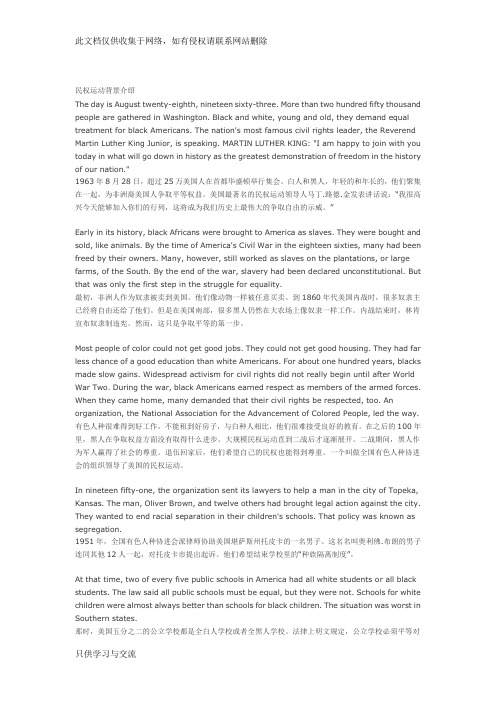
民权运动背景介绍The day is August twenty-eighth, nineteen sixty-three. More than two hundred fifty thousand people are gathered in Washington. Black and white, young and old, they demand equal treatment for black Americans. The nation's most famous civil rights leader, the Reverend Martin Luther King Junior, is speaking. MARTIN LUTHER KING: "I am happy to join with you today in what will go down in history as the greatest demonstration of freedom in the history of our nation."1963年8月28日,超过25万美国人在首都华盛顿举行集会。
白人和黑人,年轻的和年长的,他们聚集在一起,为非洲裔美国人争取平等权益。
美国最著名的民权运动领导人马丁.路德.金发表讲话说:“我很高兴今天能够加入你们的行列,这将成为我们历史上最伟大的争取自由的示威。
”Early in its history, black Africans were brought to America as slaves. They were bought and sold, like animals. By the time of America's Civil War in the eighteen sixties, many had been freed by their owners. Many, however, still worked as slaves on the plantations, or large farms, of the South. By the end of the war, slavery had been declared unconstitutional. But that was only the first step in the struggle for equality.最初,非洲人作为奴隶被卖到美国。
美国的民权运动

美国的民权运动美国的民权运动源远流长,自19世纪初期开始至今,美国民权运动囊括了多个历史事件和社会运动,旨在推动平等和公正。
该运动的核心目标是消除对少数族裔和其他社会群体的歧视,并确保每个人都能享受到平等的权利和机会。
在美国历史上,民权运动是一个不断演变和壮大的社会运动,为实现平等权利和社会正义而不懈努力。
美国的民权运动可以追溯到19世纪初期的反奴隶制度运动。
奴隶制度在南部各州盛行,导致奴隶主和奴隶之间的严重不平等。
反奴隶制度运动的兴起,为以后的民权运动奠定了基础。
随着解放宣言的颁布和内战的爆发,奴隶制度逐渐被废除,奴隶们获得了自由。
然而,尽管法律上废除了奴隶制度,但种族歧视和不平等仍然存在,激励了更广泛的民权运动。
20世纪初期的美国,种族歧视依然严重,一些少数族裔被剥夺了基本权利,遭受到歧视和迫害。
在这种背景下,一些杰出的领袖和组织开始发起民权运动,争取平等权利和社会正义。
马丁·路德·金和罗莎·帕克斯等知名领袖崭露头角,带领民权运动走向高潮。
著名的蒙哥马利公共汽车抵制运动彻底改变了美国社会,废除了种族隔离政策,推动了《民权法案》和《选民权法案》的通过,为少数族裔争取了平等权利。
随着时间的推移,美国的民权运动逐渐扩大到其他领域,不仅关注种族平等,也涉及性别、性取向、残障等多个方面。
女权主义者、同性恋权利活动家和残障人士等不同群体加入到民权运动中,共同推动社会进步。
爱因斯坦认为“种族隔离政策引起的社会不公正是一种道德侮辱”,他曾多次公开支持民权运动,呼吁人们团结起来,反对歧视和不平等。
总的来说,美国的民权运动是一个多样化且持久的社会运动,不断为社会公正和平等权利而奋斗。
尽管取得了一些重要成就,但仍有许多挑战和障碍需要克服。
唯有社会各界通力合作,共同努力,才能实现真正的平等和公正。
希望未来,美国的民权运动能够继续发展壮大,为建设一个更加公平和包容的社会做出更大的贡献。
the civil rights movement名词解释

the civil rights movement名词解释《民权运动》是美国历史上一段重要的时期,这个运动主要是为了争取黑人的平等权利,消除种族歧视,同时也为女性和其他少数群体争取权利做出了重要的贡献。
本文将从运动的历史背景、主要事件和影响等方面进行分析和解释。
一、历史背景19世纪后期,美国南部的种族歧视和黑人奴隶制度得到了极大的发展。
黑人被视为劣等种族,被迫在社会上承受着各种不公正待遇。
到了20世纪,随着美国社会的发展,黑人开始有了更多的机会和权利,但是种族歧视依旧存在,黑人依旧面临着各种不公正待遇。
这种情况引发了黑人社区的不满和抗议,进而形成了民权运动。
二、主要事件1.布朗诉教育局案1954年,美国最高法院在布朗诉教育局案中裁决,宣布“种族隔离是违宪的”,结束了美国南部学校种族隔离制度。
这个裁决标志着民权运动的开始。
2.蒙哥马利巴士抵制运动1955年,罗莎·帕克斥资购买了一张巴士车票,但因为她是黑人,被要求坐在车上的后排。
帕克拒绝了这个要求,引发了蒙哥马利巴士抵制运动。
这个运动持续了381天,最终导致了公共交通系统的种族隔离制度的废除。
3.阿拉巴马州长华莱士的“种族隔离演讲”1963年,阿拉巴马州长乔治·华莱士在阿拉巴马大学发表了“种族隔离演讲”,强调种族隔离的合法性,并试图阻止两个黑人学生进入学校。
这个事件引发了广泛的抗议和谴责,最终导致了美国政府对种族隔离立法的废除。
4.马丁·路德·金的“我有一个梦想”1963年,马丁·路德·金在华盛顿林肯纪念堂前发表了著名的“我有一个梦想”演讲,呼吁消除种族歧视,实现平等和正义。
这个演讲成为民权运动的代表性事件之一。
5.民权法案的通过1964年,美国国会通过了民权法案,禁止在公共场所对种族、肤色、宗教、性别和国籍等方面的歧视,为民权运动的胜利划上了重要的一笔。
三、影响民权运动对美国社会产生了深远的影响。
美国黑人民权运动

黑人一般从事笨重和 最受轻视的职业 平均工 资是白人的 1/3 或 1/2 , 失业率高。大多数的白人 拥有自己的住房,而大多 数黑人都是寄人篱下,租 房居住,且在租房过程中 也会因肤色被房东刁难。
多地禁止和限制黑人教育, 在美国南部的一些州甚至出台法律 要求黑人奴隶不得受教育,尽管黑 人中的自由人可以接受教育,由于 种族隔离政策,他们与白人分开学 习,受教育机会也是有限的,教育 质量普遍低下,仅传授一些基本的 生活技能。
● 在富兰克林·罗斯福任总统期内,
联邦政府任命了一大批黑人进入联邦 各部门。 ● 黑人第一次被罗斯福称为“我们的 黑人公民”。
附加条款
祖父条款 ● 吉姆·克劳法
●
种族隔离的法律 因为剥夺了黑人学童的入学权利 而违宪
终止了 美国社会中存在已久白人和黑人 必须分别就读不同公立学校的种 族隔离现象。
中文名称:美国黑人民权运动 外文名称:African-American Civil Rights Movement 运动时间:1955年-1968年 运动地点:美国 代表人物:马丁· 路德· 金、罗莎· 帕克斯
16-19世纪 ● 欧洲殖民者从非洲劫运大批黑人 奴隶到美洲
● 黑奴被运入今美国境内,主要在 南部诸州的棉花、甘蔗种植场和矿 山当苦工
1861年-1910年: 为争取平等普选权而斗争
● 林肯在 1863 年 1 月 1 日发表《解放黑 人奴隶宣言》,黑人在法律上成为自由 人。 ● 美国国会先后在 1865 年、 1868 年和 1870 年通过宪法第 13 、 14 和 15 条修正 案,将自由权、公民权和选举权赋予黑 人。
1911年-1950年: 黑人的参政力量不断上升
在美国内战后种族隔离依然盛 行的美国南方,法律明确规定黑 人与白人在公车、餐馆等公共场 所内需分隔,且黑人必须给白人 让座。
美国黑人民权运动

事件源起
美国黑人民权运动黑人最初在美国,主要是在南方农场当黑奴。理论上,林肯总统在1863年的解放宣言中, 已经让他们获得了自由。在南北战争结束后,联邦军队占领南方期间(所谓重建时期1865年—1877年),黑人曾 获得解放宣言所赋予的平等权利。然而黑人因为穷困及教育程度较低,为求经济上的生存,必须再度依靠白人雇 用,特别是当联邦军队撤出南方后,黑人顿失联邦法律的保护,其地位又陷入类似美国内战前的状况。
一直到1967年,金博士深刻体认到黑人在美国社会的饱受歧视,绝大部分是因为经济不平等所引起,经济权 才是实质、才是根本原因,公民权只是装饰。于是,他将公民权的斗争转为经济权的斗争,发起“穷人运动” (Poor People's Campaign)。
领导人物
马丁路德金领导黑人民权运动的灵魂人物马丁·路德·金博士,出生于佐治亚州的亚特兰大市,父亲是教会 牧师,家境优渥,属中产阶级,得以接受良好的教育。金于1955年取得波士顿大学博士学位,看尽南方的种族不 平等待遇,使他在成年后积极投入民权运动。
20世纪50年代中期至60年代中期美国黑人反对种族歧视和种族压迫,争取政治经济和社会平等权利,1954年 美国联邦最高法院判定教育委员会种族隔离的学校违法,1955年阿拉巴马州蒙哥马利市,黑人公民以全面罢乘来 反对公车上的黑白隔离措施,1963年华盛顿的林肯纪念馆广场聚集二十五万名群众反种族隔离,美国民权运动领 袖马丁·路德·金博士发表著名的演说《我有一个梦想》为民权运动的高峰,其他参与的著名人物还有马尔科 姆·X(Malcolm X)等人。
美国黑人民权运动
美国民权运动的一部分
01 运动背景
03 事件演变
目录
02 事件源起 04 领导人物
美国黑人民权运动(African-American Civil Rights Movement,又译为“非裔美国人民权运动”),美 国民权运动的一部分,于1950年兴起,直至1970年,乃是经由非暴力的抗议行动,争取非裔美国人民权的群众斗 争。
民权运动
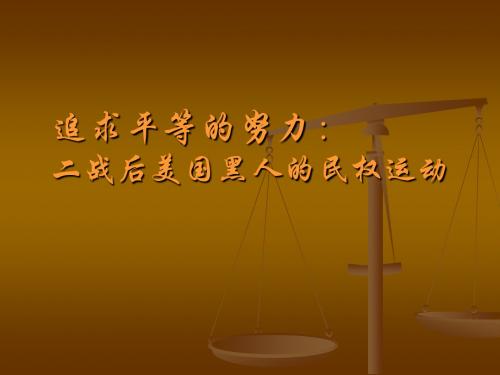
melting-pot or mosaic 地区差异
二、 “隔离但平等”
1、第十四条修正案(1868年) 第一款 所有在合众国出生或归化合众国并受其管 辖的人,都是合众国的和他们居住的州的公 民。……在州管辖范围内,也不得拒绝给予任何 人以平等法律保护。 第十五条修正案(1870年) 第一款 合众国公民的选举权,不得因种族、肤色 或以前是奴隶而被合众国或任何一州加以拒绝或 限制。 第二款 国会有权以适当立法实施本条。
4、1955年,公车事件,非暴力抵制公车运动。 5、1963年,伯明翰市反种族隔离运动 6、1963年,华盛顿游行,民权运动高潮,金 发表《我有一个梦想》 7、《1964年民权法》(Civil Rights Act of 1964)允许联邦司法部门对实行种族隔离的 公共设施和学校进行起诉,并对继续进行种 族歧视的公共性计划停发联邦资助。全面禁 止在公用设施(旅馆、饭店、戏院和体育场 所等)里实行歧视。禁止就业方面的歧视。
追求平等的努力:
二战后美国黑人的民权运动
一、公民权利(civil rights)和公民 自由(civil liberty)
1、公民权利适用于群体的权利,而无论这种群体是种族的、 人种的或宗教的。公民自由通常适用于个体公民。 2 、民权运动 civil rights movement 《权利法案》美国宪法修正案第一条至第十条 civil liberties 1941年1月罗斯福提出四大自由:freedom of speech, freedom of religion/belief, freedom from want, freedom from fear.
8、1964年,第二十四条修正案获得批准生效。 取消以税收限制选举权 9、1965年8月,国会通过选举权法。 10、1968年,金被刺杀,民权运动进入低潮。
Civil-Rights-美国民权运动背景知识

Civil-Rights-美国民权运动背景知识Civil Rights Movement in the United StatesCivil Rights Movement in the United States, political, legal, and social struggle by black Americans to gain full citizenship rights and to achieve racial equality. The civil rights movement was first and foremost a challenge to segregation, the system of laws and customs separating blacks and whites that whites used to control blacks after slavery was abolished in the 1860s. During the civil rights movement, individuals and civil rights organizations challenged segregation and discrimination with a variety of activities, including protest marches,boycotts, and refusal to abide by segregation laws. Many believe that the movement began with the Montgomery bus boycott in 1955 and ended with the Voting Rights Act of 1965, though there is debate about when it began and whether it has ended yet. The civil rights movement has also been called the Black Freedom Movement, the Negro Revolution, and the Second Reconstruction.Segregation“Whites Only” Waiting RoomA black man is ordered out of a “whites only” waiting room. Separate facilities for blacks and whites were maintained throughout the South from the end of the 19th century until the 1960s.Segregation was an attempt by white Southerners to separate the races inevery sphere of life and to achieve supremacy over blacks. Segregation was often called the Jim Crow system, after a minstrel show character from the 1830s who was an old, crippled, black slave who embodied negative stereotypes of blacks. Segregation became common in Southern states following the end of Reconstruction in 1877. During Reconstruction, which followed the Civil War (1861-1865), Republican governments in the Southern states were run by blacks, Northerners, and some sympathetic Southerners. The Reconstruction governments had passed laws opening up economic and political opportunities for blacks. By 1877 theDemocratic Party had gained control of government in the Southern states, and these Southern Democrats wanted to reverse black advances made during Reconstruction. To that end, they began to pass local and state laws that specified certain places “For Whites Only” and others for “Colored.” Blacks had separate schools, transportation, restaurants, and parks, many of which were poorly funded and inferior to those of whites. Over the next 75 years, Jim Crow signs went up to separate the races in every possible place.The system of segregation also included the denial of voting rights, known as disfranchisement. Between1890 and 1910 all Southern states passed laws imposing requirements for voting that were used to prevent blacks from voting, in spite of the 15th Amendment to the Constitution of the United States, which had been designed to protect black voting rights. These requirements included: the ability to read and write, which disqualified the many blacks who had not had access to education; property ownership, something few blacks were able to acquire; and paying a poll tax, which was too great a burden on most Southern blacks, who were very poor. As a final insult, the few blacks who made it over all these hurdles could not vote in the Democratic primaries thatchose the candidates because they were open only to whites in most Southern states.Because blacks could not vote, they were virtually powerless to prevent whites from segregating all aspects of Southern life. They could do little to stop discrimination in public accommodations, education, economic opportunities, or housing. The ability to struggle for equality was even undermined by the prevalent Jim Crow signs, which constantly reminded blacks of their inferior status in Southern society. Segregation was an all encompassing system.Conditions for blacks in Northern states were somewhat better, though upto 1910 only about 10 percent of blacks lived in the North, and prior to World War II (1939-1945), very few blacks lived in the West. Blacks were usually free to vote in the North, but there were so few blacks that their voices were barely heard. Segregated facilities were not as common in the North, but blacks were usually denied entrance to the best hotels and restaurants. Schools in New England were usually integrated, but those in the Midwest generally were not. Perhaps the most difficult part of Northern life was the intense economic discrimination against blacks. They had to compete with large numbers of recent European immigrants for job opportunities andalmost always lost.Company E, 4th U.S. Colored Infantry Black soldiers fought in segregated all-black units, such as this one, during the American Civil War (1861-1865). Almost all black soldiers fought for the Union army, and they served in nearly 500 engagements. Twenty-four black soldiers and sailors were awarded the Medal of Honor for bravery, the U.S.military’s highest honor.Segregation and ViolenceKu Klux KlanFormer Confederate soldiers founded the Ku Klux Klan (KKK) after the American Civil War (1861-1865). The KKK used violence and intimidation to prevent blacks from voting and holding office, and to keep them segregated.Throughout the South, segregation had the support of the legal system and the police. Beyond the law, however, there was always the threat of terrorist violence against blacks who attempted to challenge or even question the established order. During Reconstruction, the Ku Klux Klan (KKK), the Knights of the White Camellia, and other terrorist organizations murdered thousands of blacks and some whites in order to prevent them from voting and participating in public life. The KKK was founded in the winter of 1865 to 1866 by a former Confederate generalto stop both blacks and Northerners from carrying out their government and social reforms. The Klan and other white terrorist groups directed their violence against black landowners, politicians, and community leaders, as well as whites who supported the Republican Party or racial equality. During Reconstruction only the presence of the U.S. Army prevented massive killings; however, there were never enough soldiers to stop the violence. For example, in 1876 and 1877 mobs of whites, led by former Confederate generals, killed scores of blacks in South Carolina to prevent them from voting or holding office.School DesegregationDesegregation in Little RockIn 1957 nine black students desegregated Little Rock, Arkansas’s Central High School, despite strong resistance by many white members of the community. President Dwight Eisenhower called out federal troops to enforce the desegregation and to ensure the safety of the students.Shown here are six of the “Little Rock Nine.” With them, in the center of the picture, are Thurgood Marshall, then a lawyer for the National Association for the Advancement of Colored People (NAACP) and Daisy Bates, president of the Little Rock NAACP.In the postwar years, the NAACP's legal strategy for civil rights continued to succeed. Led by Thurgood Marshall, the NAACP Legal Defense Fund challenged and overturned many forms of discrimination, but their main thrust was equal educational opportunities. For example, in Sweat v. Painter(1950), the Supreme Court decided that the University of Texashad to integrate its law school. Marshall and the Defense Fund worked with Southern plaintiffs to challenge the Plessy doctrine directly, arguing in effect that separate was inherently unequal. The U.S. Supreme Court heard arguments on five cases that challenged elementary- and secondary-school segregation, and in May 1954 issued its landmark ruling in Brown v. Board of Education that stated that racially segregated education was unconstitutional.Montgomery Bus BoycottDespite the threats and violence, the struggle quickly moved beyond schooldesegregation to challenge segregation in other areas. On December 1, 1955, Rosa Parks, a member of the Montgomery, Alabama, branch of the NAACP, was told to give up her seat on a city bus to a white person. When Parks refused to move, she was arrested. The local NAACP, led by Edgar D. Nixon, recognized that the arrest of Parks might rally local blacks to protest segregated buses. Montgomery's black community had long been angry about their mistreatment on city buses where white drivers were often rude and abusive. The community had previously considered a boycott of the buses, and almost overnight one wasorganized. The Montgomery bus boycott was an immediate success, with virtually unanimous support from the 50,000 blacks in Montgomery. It lasted for more than a year and dramatized to the American public the determination of blacks in the South to end segregation. In November 1956 the Supreme Court upheld a federal court decision that ruled the bus segregation unconstitutional. The decision went into effect December 20, 1956, and the black community of Montgomery ended its boycott the next day.Rosa ParksIn 1955 Rosa Parks was arrested for disobeying a segregation law in Montgomery, Alabama, that required her to give up her seat on a bus to a white person. Her bold action helped to stimulate protests against inequality. The blacks in the community organized a boycott of the bus system. The boycott, which was led by MartinLuther King, Jr., forced city officials to repeal the discriminatory law.Sit-insSit-Ins in Greensboro, North Carolina In 1960 four black college students walked into a Woolworth store in Greensboro, North Carolina, and sat down at the lunch counter, which was for white customers only. The studentswaited to be served until the store closed for the day. For the next six days, a growing number of students joined the sit-ins until Woolworth closed its doors. Then the students decided to suspend the sit-ins for two weeks to give stores in the community the chance to desegregate.Freedom RidersBurned Bus in Anniston, Alabama Freedom Riders sit by their bus which had been burned by a white mob in Anniston, Alabama. Several of the riders were beaten by the mob. Freedom Riders began traveling through the South in 1961 to try to desegregate Southern bus stations.Civil Rights March, 1963The national civil rights leadershipdecided to keep pressure on both the Kennedy administration and the Congress to pass the civil rights legislation proposed by Kennedy by planning a March on Washington for August 1963. It was a conscious revival of A. Philip Randolph's planned 1941 march, which had yielded a commitment to fair employment during World War II. Randolph was there in 1963, along with the leaders of the NAACP, CORE, SCLC, the Urban League, and SNCC. Martin Luther King, Jr., delivered a moving address to an audience of more than 200,000 civil rights supporters. His “I Have a Dream” speech in front of the giant sculpture of the Great Emancipator,Abraham Lincoln, became famous for how it expressed the ideals of the civil rights movement.。
civil rights movement

从刚刚那个小故事中,你看出瑞典这样的 从刚刚那个小故事中, 北欧国家有什么特色? 北欧国家有什么特色?
美 丽 的 瑞 典 , 安 逸 的 生 活
北欧国家实行的高福利政策, 北欧国家实行的高福利政策,让国 国家实行的高福利政策 人安居乐业,营造了安定、 人安居乐业,营造了安定、祥和的社 会氛围,贫富悬殊相对较小, 会氛围,贫富悬殊相对较小,群体之 间利害冲突较少。 间利害冲突较少。这些国家的社会治 也较好。 安也较好。 在北欧,人们收入的60% 在北欧,人们收入的 %要上交税 款,国家财政的主要支出是各项社会 救助和福利事业。 救助和福利事业。
美国其它民权运动 ——女权运动
历史上, 历史上,美国一直是男性 的天下, 的天下,妇女的天职是家庭 主妇。 主妇。偶有女性工低作也多 半是比较职位, 半是比较职位,而且同工不 同酬。 同酬。女性的尊严得不到体 女性的才能被掩盖。 现,女性的才能被掩盖。 美国妇女现在的地位是 经过长期不懈的斗争得来的。 经过长期不懈的斗争得来的。
I have a dream that my four children will one day live in a nation where they will not be judged by the color of their skin but by the content of their character.
北欧国家福利制度的利与弊
甲方
利大于弊
乙方
弊大于利
冰岛
丹麦
挪威
瑞典
芬兰
1. 美国黑人民权运动的领袖人物是? 美国黑人民权运动的领袖人物是? 2.20世纪 年代,美国社会结构呈什 世纪70年代 世纪 年代, 么形状? 么形状?
Civil Rights Movement 美国民权运动PPT

• 1988 -- Congress passes Civil Rights Restoration Act over President Reagan's veto. • 1989 -- L. Douglas Wilder (Virginia) becomes first black elected governor.
• The boycott gained support from black community. • About 50 000 blacks participated
• Since the city’s black population who were the drivers of the boycott were also the main pary of the system‘s ridership. • crippling financial deficit for the Montgomery public transit system
Civil rights movement
• A. What is civil rights movement ? • B. How did it come about? Or what was the background then?
• C. Big events timeline and great figures
Victory
• on November 13, 1956, the Supreme Court ruled that Montgomery racial segregation laws for buses were illegal.
• 1957 -- Arkansas Gov. uses National Guard to block nine black students from attending a Little Rock High School; following a court order, President Eisenhower sends in Federal Troops to ensure compliance.
美国民权运动
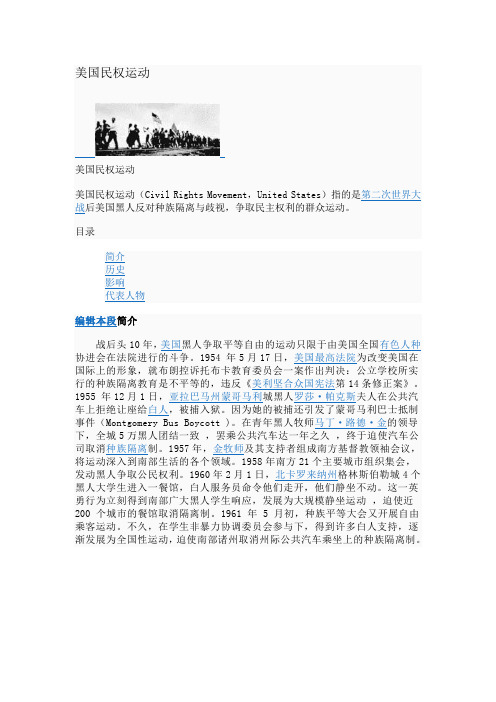
编辑本段民权运动1963年3月,金牧师等人在南部种族隔离极严重的伯明翰组织示威游行,要求取消全城隔离制。
示威群众受到残酷镇压,但由于金牧师的坚持和美国联邦政府被迫进行干预,该城种族隔离制全部被取消。
伯明翰事件后,民权运动队伍迅速扩大。
1963年8月28日组织25万人(其中1/4为白人)向华盛顿进军,要求就业,要求“立即自由”。
另外,有些城市黑人还开展以暴力对付暴力的斗争。
1964年迫使林登·约翰逊总统签署了《民权法》。
但南部诸州仍采用各种手法阻止黑人选民登记。
于是,金牧师等在种族主义非常猖獗的亚拉巴马州塞尔马市进行黑人选民登记运动,并于1965年3月冒着被殴打、杀害的危险由塞尔马向州首府蒙哥马利进军,最后参加人数达15万。
在世界人民谴责面前,美国政府于同年8月要求国会通过了《选民登记法》。
上述两法未能实际完全取消南部种族隔离与歧视制度,而北部事实上的种族歧视还有加剧之势。
1968 年3月,金牧师组织贫民进军(又称穷人运动),途经田纳西州孟菲斯市时,被种族主义分子枪杀。
后来黑人领袖们发起的民族自决运动、黑人权力运动、黑豹党运动以及黑人群众自发的大规模城市骚动等,实际上都是以不同形式反对事实上的种族隔离制,特别是就业歧视制度的民权运动的继续。
美国黑人民权运动是现代非暴力运动的典型,在全世界被压迫阶级之中影响深远,它使人们看到可以通过合法的群众运动获得民主权利的可能,也使人看到世界必将走向民主平等的趋势。
编辑本段历史1861年至1910年:为争取平等普选权而斗争 1861年,美国内战爆发。
为了在内战中赢得胜利,林肯在1862年发布了著名的《解放黑人奴隶宣言》,黑人在法律上成为自由人。
内战结束之后,美国黑人开始了争取获得平等普选权的艰苦斗争。
迫于压力,美国国会先后在1865年、1868年和1870年通过宪法第13、14和15条修正案,将自由权、公民权和选举权赋予黑人。
虽然各州还通过具体的选举附加条款对黑人参政加以限制,黑人仍无法取得与白人一样的平等地位,依然处处受到歧视,但是,这一时期仍然是美国黑人参政历史上具有里程碑意义的时代。
Civil Rights Movement 美国民权运动(课堂PPT)

the system of segregation used on Montarks in 1955,
February 4, 1913-24, 2005
(aged 92)
10
Trigger of the boycott
one of the pioneers of the civil rights movement
• 1968 -- Martin Luther King Jr. was assassinated in Memphis, Tennessee;
18
• 1973 -- Maynard Jackson ,first black elected mayor of a major Southern U.S. city-- Atlanta
ba14BA26C(ps).pdf • /archiver/GMAT_RC/thread
-222352-1.html • / • / • /Detail.aspx?pid=X5ZKbylCSoU%
21
Black man was savaged by the police
demonstrator against ra2c2ism
23
references
• /wiki/Montgomery_Bus_Boycott • /epublish/node4/node1995/pdf/qn
19
• 1991 -- Civil rights museum opens at King assassination site in Memphis.
• 2009 -- Barack Obama took the office of white house in 2009
英语 美国民权
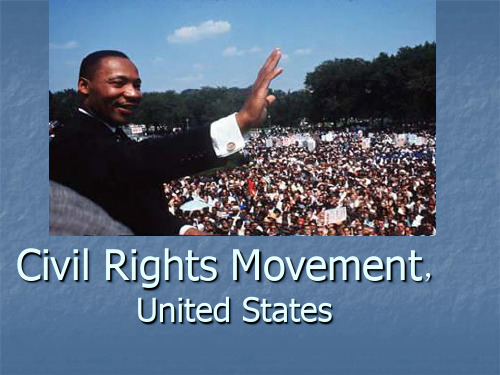
1954年联邦最高法院,在“布朗诉教育委员会”(Brown v. Board of 年联邦最高法院, 布朗诉教育委员会” Education)一案,判定种族隔离的学校并未提供黑人学生公平教育,因此 )一案,判定种族隔离的学校并未提供黑人学生公平教育, 公立学校应该要种族混合。 公立学校应该要种族混合。
罗莎事件
帕克斯被捕事件意外地造成了美国历史上一场惊天动 地的人权运动。帕克斯遭到监禁后, 地的人权运动。帕克斯遭到监禁后,很快被一位黑人领袖 保释了出来。第二天,当地黑人领袖召开会议, 保释了出来。第二天,当地黑人领袖召开会议,在了解到 蒙哥马利的公共汽车公司严重依赖黑人乘客之后, 蒙哥马利的公共汽车公司严重依赖黑人乘客之后,他们决 定从12月 日开始抵制所有的公共汽车 发生在1955年 日开始抵制所有的公共汽车。 定从 月5日开始抵制所有的公共汽车。发生在 年 冬天的这一事件也让一个叫做马丁.路德 金的26岁的黑人 路德·金的 冬天的这一事件也让一个叫做马丁 路德 金的 岁的黑人 成为了人权领袖, 成为了人权领袖,当时他正是蒙物哥马利莱克斯特洗礼教 堂的一新到的牧师。他领导人们开始了长达381天的抵制 堂的一新到的牧师。他领导人们开始了长达 天的抵制 公共汽车行动。在这场运动中, 公共汽车行动。在这场运动中,蒙哥马利市 5万黑人团结 万黑人团结 一致,宁愿步行、搭便车、骑自行车甚至骑驴出行,就是 一致,宁愿步行、搭便车、骑自行车甚至骑驴出行, 不坐公共汽车。 不坐公共汽车。
罗莎事件
1955年12月1日,在美国阿拉巴马州(南北 年 月 日 在美国阿拉巴马州(
战争期间美利坚联盟国的首都, 战争期间美利坚联盟国的首都,也是实施种族隔 离制的代表性城市之一。 离制的代表性城市之一。)蒙特马利镇的一辆
CivilRights美国民权运动背景知识
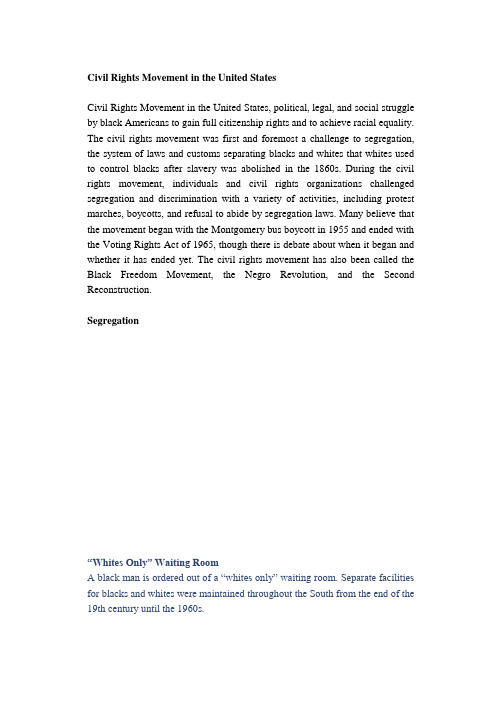
Civil Rights Movement in the United StatesCivil Rights Movement in the United States, political, legal, and social struggle by black Americans to gain full citizenship rights and to achieve racial equality. The civil rights movement was first and foremost a challenge to segregation, the system of laws and customs separating blacks and whites that whites used to control blacks after slavery was abolished in the 1860s. During the civil rights movement, individuals and civil rights organizations challenged segregation and discrimination with a variety of activities, including protest marches, boycotts, and refusal to abide by segregation laws. Many believe that the movement began with the Montgomery bus boycott in 1955 and ended with the Voting Rights Act of 1965, though there is debate about when it began and whether it has ended yet. The civil rights movement has also been called the Black Freedom Movement, the Negro Revolution, and the Second Reconstruction.Segregation“Whites Only” Waiting RoomA black man is ordered out of a “whites only” waiting room. Separate facilities for blacks and whites were maintained throughout the South from the end of the 19th century until the 1960s.Segregation was an attempt by white Southerners to separate the races in every sphere of life and to achieve supremacy over blacks. Segregation was often called the Jim Crow system, after a minstrel show character from the 1830s who was an old, crippled, black slave who embodied negative stereotypes of blacks. Segregation became common in Southern states following the end of Reconstruction in 1877. During Reconstruction, which followed the Civil War (1861-1865), Republican governments in the Southern states were run by blacks, Northerners, and some sympathetic Southerners. The Reconstruction governments had passed laws opening up economic and political opportunities for blacks. By 1877 the Democratic Party had gained control of government in the Southern states, and these Southern Democrats wanted to reverse black advances made during Reconstruction. To that end, they began to pass local and state laws that specified certain places “For Whites Only” and others for “Colored.” Blacks had separate schools, transportation, restaurants, and parks, many of which were poorly funded and inferior to those of whites. Over the next 75 years, Jim Crow signs went up to separate the races in every possible place.The system of segregation also included the denial of voting rights, known as disfranchisement. Between 1890 and 1910 all Southern states passed laws imposing requirements for voting that were used to prevent blacks from voting, in spite of the 15th Amendment to the Constitution of the United States, which had been designed to protect black voting rights. These requirements included: the ability to read and write, which disqualified the many blacks who had not had access to education; property ownership, something few blacks were able to acquire; and paying a poll tax, which was too great a burden on most Southern blacks, who were very poor. As a final insult, the few blacks who made it over all these hurdles could not vote in the Democratic primaries that chose the candidates because they were open only to whites in most Southern states.Because blacks could not vote, they were virtually powerless to prevent whites from segregating all aspects of Southern life. They could do little to stop discrimination in public accommodations, education, economic opportunities, or housing. The ability to struggle for equality was even undermined by the prevalent Jim Crow signs, which constantly reminded blacks of their inferior status in Southern society. Segregation was an all encompassing system. Conditions for blacks in Northern states were somewhat better, though up to1910 only about 10 percent of blacks lived in the North, and prior to World War II (1939-1945), very few blacks lived in the West. Blacks were usually free to vote in the North, but there were so few blacks that their voices were barely heard. Segregated facilities were not as common in the North, but blacks were usually denied entrance to the best hotels and restaurants. Schools in New England were usually integrated, but those in the Midwest generally were not. Perhaps the most difficult part of Northern life was the intense economic discrimination against blacks. They had to compete with large numbers of recent European immigrants for job opportunities and almost always lost.Company E, 4th U.S. Colored InfantryBlack soldiers fought in segregated all-black units, such as this one, during the American Civil War (1861-1865). Almost all black soldiers fought for the Union army, and they served in nearly 500 engagements. Twenty-four black soldiers and sailors were awarded the Medal of Honor for bravery, the U.S. military’s highest honor.Segregation and ViolenceKu Klux KlanFormer Confederate soldiers founded the Ku Klux Klan (KKK) after the American Civil War (1861-1865). The KKK used violence and intimidation to prevent blacks from voting and holding office, and to keep them segregated.Throughout the South, segregation had the support of the legal system and the police. Beyond the law, however, there was always the threat of terrorist violence against blacks who attempted to challenge or even question the established order. During Reconstruction, the Ku Klux Klan (KKK), the Knights of the White Camellia, and other terrorist organizations murdered thousands of blacks and some whites in order to prevent them from voting and participating in public life. The KKK was founded in the winter of 1865 to 1866 by a former Confederate general to stop both blacks and Northerners from carrying out their government and social reforms. The Klan and other white terrorist groups directed their violence against black landowners, politicians, and community leaders, as well as whites who supported the Republican Party or racial equality. During Reconstruction only the presence of the U.S. Army prevented massive killings; however, there were never enough soldiers to stop the violence. For example, in 1876 and 1877 mobs of whites, led by former Confederate generals, killed scores of blacks in South Carolina to prevent them from voting or holding office.School DesegregationDesegregation in Little RockIn 1957 nine black students desegregated Little Rock, Arkansas’s Central High School, despite strong resistance by many white members of the community. President Dwight Eisenhower called out federal troops to enforce the desegregation and to ensure the safety of the students. Shown here are six of the “Little Rock Nine.” With them, in the center of the picture, are Thurgood Marshall, then a lawyer for the National Association for the Advancement of Colored People (NAACP) and Daisy Bates, president of the Little Rock NAACP.In the postwar years, the NAACP's legal strategy for civil rights continued to succeed. Led by Thurgood Marshall, the NAACP Legal Defense Fund challenged and overturned many forms of discrimination, but their main thrust was equal educational opportunities. For example, in Sweat v. Painter (1950), the Supreme Court decided that the University of Texas had to integrate its law school. Marshall and the Defense Fund worked with Southern plaintiffs to challenge the Plessy doctrine directly, arguing in effect that separate was inherently unequal. The U.S. Supreme Court heard arguments on five cases that challenged elementary- and secondary-school segregation, and in May 1954 issued its landmark ruling in Brown v. Board of Education that stated that racially segregated education was unconstitutional.Montgomery Bus BoycottDespite the threats and violence, the struggle quickly moved beyond school desegregation to challenge segregation in other areas. On December 1, 1955, Rosa Parks, a member of the Montgomery, Alabama, branch of the NAACP, was told to give up her seat on a city bus to a white person. When Parks refused to move, she was arrested. The local NAACP, led by Edgar D. Nixon, recognized that the arrest of Parks might rally local blacks to protest segregated buses. Montgomery's black community had long been angry about their mistreatment on city buses where white drivers were often rude and abusive. The community had previously considered a boycott of the buses, and almost overnight one was organized. The Montgomery bus boycott was an immediate success, with virtually unanimous support from the 50,000 blacks in Montgomery. It lasted for more than a year and dramatized to the American public the determination of blacks in the South to end segregation. In November 1956 the Supreme Court upheld a federal court decision that ruled the bus segregation unconstitutional. The decision went into effect December 20, 1956, and the black community of Montgomery ended its boycott the next day.Rosa ParksIn 1955 Rosa Parks was arrested for disobeying a segregation law inMontgomery, Alabama, that required her to give up her seat on a bus to a white person. Her bold action helped to stimulate protests against inequality. The blacks in the community organized a boycott of the bus system. The boycott, which was led by Martin Luther King, Jr., forced city officials to repeal the discriminatory law.Sit-insSit-Ins in Greensboro, North CarolinaIn 1960 four black college students walked into a Woolworth store in Greensboro, North Carolina, and sat down at the lunch counter, which was for white customers only. The students waited to be served until the store closed for the day. For the next six days, a growing number of students joined the sit-ins until Woolworth closed its doors. Then the students decided to suspend the sit-ins for two weeks to give stores in the community the chance to desegregate.Freedom RidersBurned Bus in Anniston, AlabamaFreedom Riders sit by their bus which had been burned by a white mob in Anniston, Alabama. Several of the riders were beaten by the mob. Freedom Riders began traveling through the South in 1961 to try to desegregate Southern bus stations.Civil Rights March, 1963The national civil rights leadership decided to keep pressure on both the Kennedy administration and the Congress to pass the civil rights legislation proposed by Kennedy by planning a March on Washington for August 1963. It was a conscious revival of A. Philip Randolph's planned 1941 march, which had yielded a commitment to fair employment during World War II. Randolph was there in 1963, along with the leaders of the NAACP, CORE, SCLC, the Urban League, and SNCC. Martin Luther King, Jr., delivered a moving address to an audience of more than 200,000 civil rights supporters. His “I Have a Dream” speech in front of the giant sculpture of the Great Emancipator, Abraham Lincoln, became famous for how it expressed the ideals of the civil rights movement.。
Civil Rights 美国民权运动背景知识
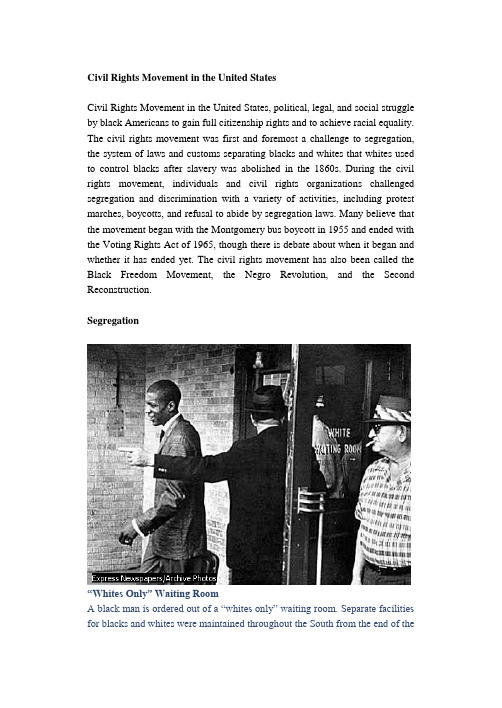
Civil Rights Movement in the United StatesCivil Rights Movement in the United States, political, legal, and social struggle by black Americans to gain full citizenship rights and to achieve racial equality. The civil rights movement was first and foremost a challenge to segregation, the system of laws and customs separating blacks and whites that whites used to control blacks after slavery was abolished in the 1860s. During the civil rights movement, individuals and civil rights organizations challenged segregation and discrimination with a variety of activities, including protest marches, boycotts, and refusal to abide by segregation laws. Many believe that the movement began with the Montgomery bus boycott in 1955 and ended with the Voting Rights Act of 1965, though there is debate about when it began and whether it has ended yet. The civil rights movement has also been called the Black Freedom Movement, the Negro Revolution, and the Second Reconstruction.Segregation“Whites Only” Waiting RoomA black man is ordered out of a “whites only” waiting room. Separate facilities for blacks and whites were maintained throughout the South from the end of the19th century until the 1960s.Segregation was an attempt by white Southerners to separate the races in every sphere of life and to achieve supremacy over blacks. Segregation was often called the Jim Crow system, after a minstrel show character from the 1830s who was an old, crippled, black slave who embodied negative stereotypes of blacks. Segregation became common in Southern states following the end of Reconstruction in 1877. During Reconstruction, which followed the Civil War (1861-1865), Republican governments in the Southern states were run by blacks, Northerners, and some sympathetic Southerners. The Reconstruction governments had passed laws opening up economic and political opportunities for blacks. By 1877 the Democratic Party had gained control of government in the Southern states, and these Southern Democrats wanted to reverse black advances made during Reconstruction. To that end, they began to pass local and state laws that specified certain places “For Whites Only” and others for “Colored.” Blacks h ad separate schools, transportation, restaurants, and parks, many of which were poorly funded and inferior to those of whites. Over the next 75 years, Jim Crow signs went up to separate the races in every possible place.The system of segregation also included the denial of voting rights, known as disfranchisement. Between 1890 and 1910 all Southern states passed laws imposing requirements for voting that were used to prevent blacks from voting, in spite of the 15th Amendment to the Constitution of the United States, which had been designed to protect black voting rights. These requirements included: the ability to read and write, which disqualified the many blacks who had not had access to education; property ownership, something few blacks were able to acquire; and paying a poll tax, which was too great a burden on most Southern blacks, who were very poor. As a final insult, the few blacks who made it over all these hurdles could not vote in the Democratic primaries that chose the candidates because they were open only to whites in most Southern states.Because blacks could not vote, they were virtually powerless to prevent whites from segregating all aspects of Southern life. They could do little to stop discrimination in public accommodations, education, economic opportunities, or housing. The ability to struggle for equality was even undermined by the prevalent Jim Crow signs, which constantly reminded blacks of their inferiorstatus in Southern society. Segregation was an all encompassing system. Conditions for blacks in Northern states were somewhat better, though up to 1910 only about 10 percent of blacks lived in the North, and prior to World War II (1939-1945), very few blacks lived in the West. Blacks were usually free to vote in the North, but there were so few blacks that their voices were barely heard. Segregated facilities were not as common in the North, but blacks were usually denied entrance to the best hotels and restaurants. Schools in New England were usually integrated, but those in the Midwest generally were not. Perhaps the most difficult part of Northern life was the intense economic discrimination against blacks. They had to compete with large numbers of recent European immigrants for job opportunities and almost always lost.Company E, 4th U.S. Colored InfantryBlack soldiers fought in segregated all-black units, such as this one, during the American Civil War (1861-1865). Almost all black soldiers fought for the Union army, and they served in nearly 500 engagements. Twenty-four black soldiers and sailors were awarded the Medal of Honor for bravery, the U.S. military’s highest honor.Segregation and ViolenceKu Klux KlanFormer Confederate soldiers founded the Ku Klux Klan (KKK) after the American Civil War (1861-1865). The KKK used violence and intimidation to prevent blacks from voting and holding office, and to keep them segregated.Throughout the South, segregation had the support of the legal system and the police. Beyond the law, however, there was always the threat of terrorist violence against blacks who attempted to challenge or even question the established order. During Reconstruction, the Ku Klux Klan (KKK), the Knights of the White Camellia, and other terrorist organizations murdered thousands of blacks and some whites in order to prevent them from voting and participating in public life. The KKK was founded in the winter of 1865 to 1866 by a former Confederate general to stop both blacks and Northerners from carrying out their government and social reforms. The Klan and other white terrorist groups directed their violence against black landowners, politicians, and community leaders, as well as whites who supported the Republican Party or racial equality. During Reconstruction only the presence of the U.S. Army prevented massive killings; however, there were never enough soldiers to stop the violence. For example, in 1876 and 1877 mobs of whites, led by former Confederate generals, killed scores of blacks in South Carolina to prevent them from voting or holding office.School DesegregationDesegregation in Little RockIn 1957 nine black students desegregated Little Rock, Arkansas’s Central High School, despite strong resistance by many white members of the community. President Dwight Eisenhower called out federal troops to enforce the desegregation and to ensure the safety of the students. Shown here are six of the “Little Rock Nine.” With them, in the center of the picture, are Thurgood Marshall, then a lawyer for the National Association for the Advancement of Colored People (NAACP) and Daisy Bates, president of the Little Rock NAACP.In the postwar years, the NAACP's legal strategy for civil rights continued to succeed. Led by Thurgood Marshall, the NAACP Legal Defense Fund challenged and overturned many forms of discrimination, but their main thrust was equal educational opportunities. For example, in Sweat v. Painter (1950), the Supreme Court decided that the University of Texas had to integrate its law school. Marshall and the Defense Fund worked with Southern plaintiffs to challenge the Plessy doctrine directly, arguing in effect that separate was inherently unequal. The U.S. Supreme Court heard arguments on five cases that challenged elementary- and secondary-school segregation, and in May 1954 issued its landmark ruling in Brown v. Board of Education that stated thatracially segregated education was unconstitutional.Montgomery Bus BoycottDespite the threats and violence, the struggle quickly moved beyond school desegregation to challenge segregation in other areas. On December 1, 1955, Rosa Parks, a member of the Montgomery, Alabama, branch of the NAACP, was told to give up her seat on a city bus to a white person. When Parks refused to move, she was arrested. The local NAACP, led by Edgar D. Nixon, recognized that the arrest of Parks might rally local blacks to protest segregated buses. Montgomery's black community had long been angry about their mistreatment on city buses where white drivers were often rude and abusive. The community had previously considered a boycott of the buses, and almost overnight one was organized. The Montgomery bus boycott was an immediate success, with virtually unanimous support from the 50,000 blacks in Montgomery. It lasted for more than a year and dramatized to the American public the determination of blacks in the South to end segregation. In November 1956 the Supreme Court upheld a federal court decision that ruled the bus segregation unconstitutional. The decision went into effect December 20, 1956, and the black community of Montgomery ended its boycott the next day.Rosa ParksIn 1955 Rosa Parks was arrested for disobeying a segregation law in Montgomery, Alabama, that required her to give up her seat on a bus to a white person. Her bold action helped to stimulate protests against inequality. The blacks in the community organized a boycott of the bus system. The boycott, which was led by Martin Luther King, Jr., forced city officials to repeal the discriminatory law.Sit-insSit-Ins in Greensboro, North CarolinaIn 1960 four black college students walked into a Woolworth store in Greensboro, North Carolina, and sat down at the lunch counter, which was for white customers only. The students waited to be served until the store closed for the day. For the next six days, a growing number of students joined the sit-ins until Woolworth closed its doors. Then the students decided to suspend the sit-ins for two weeks to give stores in the community the chance to desegregate.Freedom RidersBurned Bus in Anniston, AlabamaFreedom Riders sit by their bus which had been burned by a white mob in Anniston, Alabama. Several of the riders were beaten by the mob. Freedom Riders began traveling through the South in 1961 to try to desegregate Southern bus stations.Civil Rights March, 1963The national civil rights leadership decided to keep pressure on both the Kennedy administration and the Congress to pass the civil rights legislation proposed by Kennedy by planning a March on Washington for August 1963. It was a conscious revival of A. Philip Randolph's planned 1941 march, which had yielded a commitment to fair employment during World War II. Randolph was there in 1963, along with the leaders of the NAACP, CORE, SCLC, the Urban League, and SNCC. Martin Luther King, Jr., delivered a moving address to an audience of more than 200,000 civil rights supporters. His “I Have a Dream” speech in front of the giant sculpture of the Great Emancipator, Abraham Lincoln, became famous for how it expressed the ideals of the civil rights movement.。
美国的民权运动
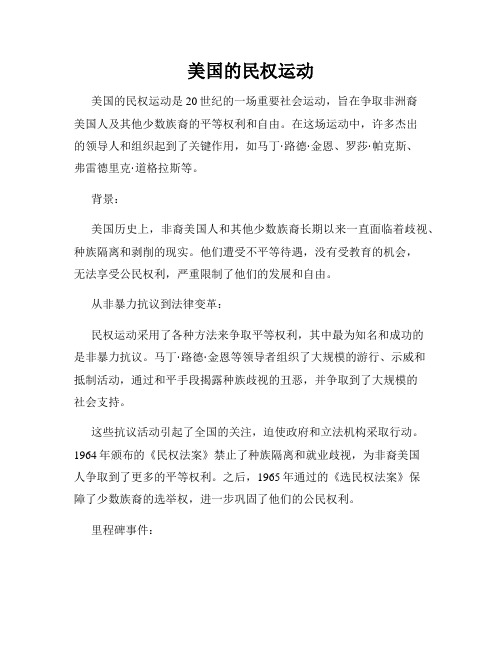
美国的民权运动美国的民权运动是20世纪的一场重要社会运动,旨在争取非洲裔美国人及其他少数族裔的平等权利和自由。
在这场运动中,许多杰出的领导人和组织起到了关键作用,如马丁·路德·金恩、罗莎·帕克斯、弗雷德里克·道格拉斯等。
背景:美国历史上,非裔美国人和其他少数族裔长期以来一直面临着歧视、种族隔离和剥削的现实。
他们遭受不平等待遇,没有受教育的机会,无法享受公民权利,严重限制了他们的发展和自由。
从非暴力抗议到法律变革:民权运动采用了各种方法来争取平等权利,其中最为知名和成功的是非暴力抗议。
马丁·路德·金恩等领导者组织了大规模的游行、示威和抵制活动,通过和平手段揭露种族歧视的丑恶,并争取到了大规模的社会支持。
这些抗议活动引起了全国的关注,迫使政府和立法机构采取行动。
1964年颁布的《民权法案》禁止了种族隔离和就业歧视,为非裔美国人争取到了更多的平等权利。
之后,1965年通过的《选民权法案》保障了少数族裔的选举权,进一步巩固了他们的公民权利。
里程碑事件:1. 蒙哥马利公交车抵制运动(1955-1956):罗莎·帕克斯的拒绝让座事件引发了全市范围的抵制运动,最终迫使当地政府废除了种族隔离政策。
2. 十字路口抵抗(1960):非裔美国学生在南方各地的白人餐馆进行了抗议,要求结束种族隔离。
3. 华盛顿大游行(1963):马丁·路德·金恩发表了著名的“我有一个梦想”的演讲,呼吁平等和种族和解。
4. 1964年民权法案:禁止种族隔离和就业歧视,确保所有人的平等权利。
5. 1965年选民权法案:保障少数族裔的选举权,消除了投票歧视。
影响:美国的民权运动对全球范围内的社会变革产生了积极的影响。
它鼓舞了其他国家和地区的民权运动,激发了更广泛的社会变革运动。
此外,这场运动对改变美国的社会结构和价值观起到了关键作用,使得种族平等成为一个核心价值。
美国民权运动与种族平等

美国民权运动与种族平等美国民权运动是20世纪最重要的社会运动之一,它致力于消除种族歧视,争取种族平等。
这场运动在美国历史上产生了深远的影响,不仅改变了美国社会结构,也对世界其他国家的民权运动产生了启发。
本文将探讨美国民权运动的起源、重要人物以及取得的成就。
一、起源和背景美国民权运动的起源可以追溯到19世纪末的奴隶制度废除运动。
当时,南部的黑人奴隶们生活在极其恶劣的环境中,遭受着严重的歧视和压迫。
废奴运动的兴起为后来的民权运动奠定了基础。
然而,直到20世纪,种族歧视依然存在。
黑人在社会、政治和经济方面仍然受到限制。
这种不公平的现象引发了一系列的抗议和反抗,逐渐形成了美国民权运动。
二、重要人物在美国民权运动中,有许多重要的人物起到了关键的作用。
其中最著名的是马丁·路德·金恩(Martin Luther King Jr.)。
他是一位非暴力抗议的倡导者,通过演讲和抗议活动,致力于消除种族歧视。
他的著名演讲《我有一个梦想》在全球范围内产生了广泛的影响。
另外一个重要的人物是罗莎·帕克斯(Rosa Parks)。
她是一位黑人妇女,因为拒绝在公交车上让座给白人而引发了一场抗议。
这个事件成为了美国民权运动的重要转折点,引发了著名的蒙哥马利公交车抵制运动。
除了马丁·路德·金恩和罗莎·帕克斯,还有许多其他的重要人物,如马尔科姆·X (Malcolm X)、约翰·刘易斯(John Lewis)等,他们都为美国民权运动做出了重要的贡献。
三、取得的成就美国民权运动取得了许多重要的成就,其中最重要的是通过立法废除了种族隔离政策。
在60年代,美国通过了一系列的民权法案,禁止了种族隔离和歧视。
这些法案的通过为黑人争取到了平等的权利和机会。
此外,美国民权运动还促进了黑人参与政治和社会生活的机会。
在民权运动的推动下,越来越多的黑人成为了政治家、企业家和社会活动家。
- 1、下载文档前请自行甄别文档内容的完整性,平台不提供额外的编辑、内容补充、找答案等附加服务。
- 2、"仅部分预览"的文档,不可在线预览部分如存在完整性等问题,可反馈申请退款(可完整预览的文档不适用该条件!)。
- 3、如文档侵犯您的权益,请联系客服反馈,我们会尽快为您处理(人工客服工作时间:9:00-18:30)。
Civil Rights Movement in the United States
Civil Rights Movement in the United States, political, legal, and social struggle by black Americans to gain full citizenship rights and to achieve racial equality. The civil rights movement was first and foremost a challenge to segregation, the system of laws and customs separating blacks and whites that whites used to control blacks after slavery was abolished in the 1860s. During the civil rights movement, individuals and civil rights organizations challenged segregation and discrimination with a variety of activities, including protest marches, boycotts, and refusal to abide by segregation laws. Many believe that the movement began with the Montgomery bus boycott in 1955 and ended with the Voting Rights Act of 1965, though there is debate about when it began and whether it has ended yet. The civil rights movement has also been called the Black Freedom Movement, the Negro Revolution, and the Second Reconstruction.
Segregation
“Whites Only” Waiting Room
A black man is ordered out of a “whites only” waiting room. Separate facilities for blacks and whites were maintained throughout the South from the end of the 19th century until the 1960s.
Segregation was an attempt by white Southerners to separate the races in every sphere of life and to achieve supremacy over blacks. Segregation was often called the Jim Crow system, after a minstrel show character from the 1830s who was an old, crippled, black slave who embodied negative stereotypes of blacks. Segregation became common in Southern states following the end of Reconstruction in 1877. During Reconstruction, which followed the Civil War (1861-1865), Republican governments in the Southern states were run by blacks, Northerners, and some sympathetic Southerners. The Reconstruction governments had passed laws opening up economic and political opportunities for blacks. By 1877 the Democratic Party had gained control of government in the Southern states, and these Southern Democrats wanted to reverse black advances made during Reconstruction. To that end, they began to pass local and state laws that specified certain places “For Whites Only” and others for “Colored.” Blacks had separate schools, transportation, restaurants, and parks, many of which were poorly funded and inferior to those of whites. Over the next 75 years, Jim Crow signs went up to separate the races in every possible place.
The system of segregation also included the denial of voting rights, known as disfranchisement. Between 1890 and 1910 all Southern states passed laws imposing requirements for voting that were used to prevent blacks from voting, in spite of the 15th Amendment to the Constitution of the United States, which had been designed to protect black voting rights. These requirements included: the ability to read and write, which disqualified the many blacks who had not had access to education; property ownership, something few blacks were able to acquire; and paying a poll tax, which was too great a burden on most Southern blacks, who were very poor. As a final insult, the few blacks who made it over all these hurdles could not vote in the Democratic primaries that chose the candidates because they were open only to whites in most Southern states.
Because blacks could not vote, they were virtually powerless to prevent whites from segregating all aspects of Southern life. They could do little to stop discrimination in public accommodations, education, economic opportunities, or housing. The ability to struggle for equality was even undermined by the prevalent Jim Crow signs, which constantly reminded blacks of their inferior status in Southern society. Segregation was an all encompassing system. Conditions for blacks in Northern states were somewhat better, though up to。
